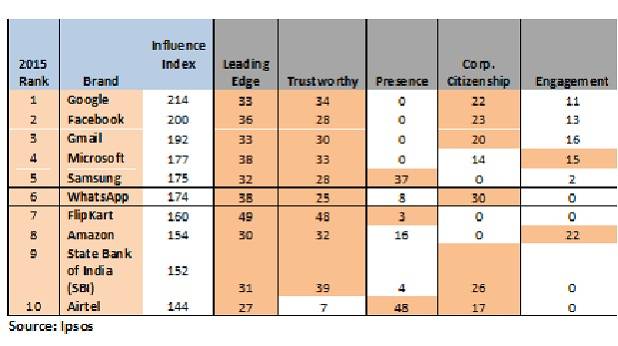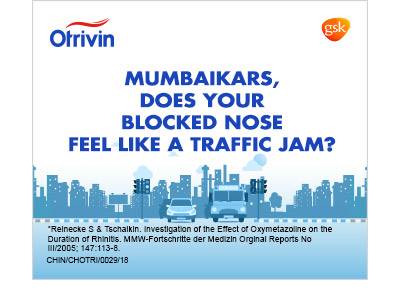Google, Facebook, Gmail are most influential brands in India: Ipsos study
Ipsos has unveiled the Top 10 Most Influential Brands in India. Google occupies the No. 1 position, followed by Facebook, Gmail, Microsoft, Samsung, WhatsApp, Flipkart, Amazon, SBI, and Airtel.
The Ipsos Most Influential Brand Study evaluates 100+ brands across 21 countries and involved 36,600 interviews. In India, where the study was conducted for the first time, Ipsos canvassed the country to ask more than 1,000 Indians online to assess 100+ brands.
“Brands are more than just corporate logos. They have meaning, personality, even attitude,” explained Amit Adarkar, Managing Director, Ipsos, India. “When it comes to asking which brand is the most trustworthy, has the most presence or is most engaging, the answer can be a personal one. This is because we increasingly identify with, relate to and define ourselves by them, which gives brands something we can measure: influence.”
The goal of the study was to define and measure influence; to rank brands according to their influence within each country; rank brands according to their influence globally and identify what factors explain or drive the current level of influence for each of the brands at the country level and at the global level.
However, there is a word about limitations. It is important to note that the Ipsos study has measured the biggest, most well-known and/or highest spending brands only. As a result, the Ipsos Most Influential Brand Study did not look at the entire market.
A factor analysis was conducted using the 57 statements in the questionnaire and a total of six factors were revealed from this analysis. One of these factors contained 11 statements and was clearly the “Influence” factor. The average score across the 11 statements in the Influence factor was defined as the Influence Score for any given brand. The score was then converted to an index by dividing by the average Influence Score across all brands, multiplied by 100.
The five remaining factors were used as attributes to help explain what makes each brand influential (as it varies from brand to brand). These five factors are: Leading Edge, Corporate Citizenship, Trustworthiness, Presence, and Engagement.
The Top 10 brands in India are combination of digital service/ social media, technology, online retail, bank and telecom brands. The one thing that many of these brands have in common are that they are Leading Edge and Trustworthy, which results in them being so firmly entrenched in the minds of consumer.
Following is the Top Ten countdown along with their overall influence index score and the primary influence drivers associated with each brand.
“The role brands play in our lives and the world at large is becoming more important. From improving our personal well-being to transforming the communities and societies we live in, many brands today are driven to make a dent in the universe,” added Adarkar.
Some, of course, have a bigger impact than others. These visionary brands go well beyond selling a product or service. They are founded on a sense of purpose – or ‘why’ – that establishes stronger emotional connections with people. In addition, new technologies have opened up ways to listen to what consumers want. Brands that use the troves of data to their benefit have more relevance than ever before. Their influence in our lives, and in our world, cannot be overstated.
The study ranks brands according to their influence and within each of 21 countries: Australia, Belgium, Brazil, Canada, China, Colombia, France, Germany, India, Italy, Kenya, Mexico, New Zealand, Nigeria, Russia, Sweden, Taiwan, Thailand, Turkey, UK and the USA.
Being influential means having an impact on people’s lives. We place a tremendous degree of trust in these brands, and give them the power to guide how we shop, interact, and behave. Influential brands have aspirational qualities, too. They offer a gateway to a better, more interesting life by giving people the tools to make smart choices. Indeed, this explains why a number of technology brands appear in the Top Ten.
The Most Influential Brands are important and relevant in the world. Consumers identify with these brands and have an emotional relationship with them. They couldn’t imagine their lives without them. Achieving any of these things is no easy task.
What influential brands bring to the table and what separates the winners from the rest
The dynamically evolving consumer landscape has a big impact on any brand’s influence. In a world increasingly connected by technology, consumers have too many options available at a moment’s notice.
“E-commerce is a classic example – it brings a shop with thousands of options to a consumer’s mobile phone at any time or place of his/ her convenience. The same goes with media consumption or entertainment. This glut of options is leading to shorter consumer attention spans. Ergo, brands have to fight for continuous share of attention with consumers connected 24x7 and spoilt by too many choices. A tough task indeed! This is where influential brands could become game-changers,” added Adarkar.
Unlike any liked or preferred brand, an influential brand can take the consumer relationship to the next level. It will impact consumers’ lives and can guide the way people behave in a manner that consumers couldn’t imagine their lives without them. There are five pillars of brand influence:
Needs to be seen as trustworthy: Trust is the cornerstone of any great relationship. And the most influential brands have this in spades. People use them, rely on them, and believe in them. When they really trust a brand, they will listen to what it has to say and will tell others about it. Without trust, a brand cannot hope to be influential.
Engaging with consumers: A brand is a relationship and the more vested people are in that relationship, the more influence it will have in their lives. In today’s world, that means connecting and interacting with the brand in more ways than just at the point-of-sale. Influential brands are talked about, loved and people want to know more about them.
Not surprisingly, in the top 10 list for India, we see a lot of technology/ e-commerce brands. The only non-technology brands – Airtel (helps me engage) and SBI (physical distribution leads to more engagement) – also show characteristics of connectedness.
Leading edge: Influential brands zig when all the others zag. They are iconic, edgy, unconventional, innovative, and unique. Being trendsetters, they set an example, shape behaviour, and change the landscape. Other brands aspire to follow them because of this. Being leading-edge helps influential brands be aspirational so that consumers feel like engaging with them all the time.
Corporate citizenship: People expect brands to make a difference to the community. Some of the brands that rank as most influential are committed to doing the right thing. They are environmentally and socially responsible, an active member of the community, and even inspire a sense of national pride. These traits help influential brands in developing a strong and self-sustaining community of brand advocates.
Presence: To be influential, you have to be seen, heard, and known. That means being out there and/or inspiring an army of advocates to do the job for you. This is where the biggest, boldest, and paid marketing efforts get to work – promotion, placement, and people. You have to be seen in order to create influence. To do this, influential brands rely on providing a total and media-agnostic consumer experience. Influential brands are also able to customise experience for an individual consumer, thus leading to intimacy.
The understanding of the five pillars of brand influence brings us to an interesting question. Is the brand’s ability to generate influence somewhat tied to the nature of the category it lives in? The pillars of brand influence are generic. To that extent, the ability to generate influence need not depend upon the nature of category, though the role of various pillars may differ from category to category. Technology brands may find it easier to engage with consumers, but FMCG brands may find it easier to establish trust as consumers can touch, feel and experience tangible products. There is another way to look at the role of category in generating influence. In today’s world, category boundaries are getting fuzzier and the category definition may be unique to each consumer.
Take entertainment, as an example. The options (and hence category definition) will be drastically different for a feature-phone-using housewife in a small town and a teenager carrying the latest smartphone with a 4G data connection. After all, brand influence is about touching and influencing people’s lives. And influential brands go about touching people’s lives in a smart and nimble-footed way.
Do influential brands show positive trends in share price? Influential brands indeed show positive trends in share price. Comparing the growth of the Dow/ Nasdaq/ BSE/ NSE over the past several years with the stocks of our Top Ten Most Influential Brands, it is clear that influential brands have more value and that this is consistently the case.
Methodology
The Most Influential Brands study was conducted in December 2015. The online survey of 1,000 adult residents of India was conducted using the Ipsos iSay Panel. The results are based on a sample where weighting was employed to balance demographics and ensure that the sample’s composition reflects that of the actual Indian population according to Census data. The precision of Ipsos online polls is measured using a credibility interval. In this case, the results are considered accurate to within +/- 5 percentage points.






















Share
Facebook
YouTube
Tweet
Twitter
LinkedIn